St. Mary Armenian Apostolic Church
St. Mary Armenian Apostolic Church continues to evolve over the last 80 years alongside the Armenian community in the Washington, D.C. Metropolitan area. Today, an estimated ten thousand Armenians live in the area, engaging in a wide range of professional activities running businesses, Federal and local governments, non-profit organizations and the arts. St. Mary consistently develops to continue serving an important role as a center for religious and cultural activity within the Armenian community.

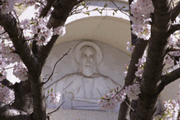
1880-1914
In the 1880’s, Boghos Casparian from Boorhans (Sivas Province, Asia Minor) was among the first of the Armenians to settle in Washington. Casparian was a rug merchant and the proprietor of a rug cleaning business. Following in his footsteps, from 1880 to 1914, approximately 150 Armenians came to Washington. Some arrived to pursue business opportunities whilst others attended local universities.
In 1908, when the Ottoman Empire announced what were thought to be increased freedoms for the minority communities, some Armenians choose to return home. The immigrants who chose to remain in the United States went on to join the fabric of Washington's society. One of these early Armenians to adopt the city as their own was Movses Hekimian. Together with his wife and four children, Hekimian founded the first Oriental rug store in the Nation’s capital. Other early pioneers were Armenag Lousararian and his sister; Dr. Nazaret Kurkjian; and Ardashes Nersessian, who was known by his pen name “Malkhas”. They were later joined by other new arrivals, including Dr. Dolmage, Mihran Nakkashian, Neshan Hintlian, Nejib Hekimian, Ohannes Nersessian, Aram Panossian, and Adam Arabian. Arabian eventually moved to Baltimore, where he settled with his family, including his daughter the distinguished judge: The Honorable Mary Arabian.
Until 1915, little information is available regarding organized Armenian community activities. As atrocities committed against Armenians in the Ottoman Empire grew, news of deportations and attempted systematic annihilation filtered through to the press in the United States. In 1915 the Washington Chapter of the Armenian General Benevolent Union (AGBU) was established with 19 members as a national consciousness began to grow within the Armenian community.
World War I
By the middle of World War I, a new wave of Armenian immigrants from abroad as well as other U.S. cities began to settle in the Washington, DC area. However, the community remained without a church or parish priest. This meant that in order to attend regular religious services, Armenians needed to travel to Philadelphia or New York. Eventually, visiting clergy helped to provide support for holidays and sacramental needs.
In 1918, the Republic of Armenia established its first Embassy in Washington. The Honorable Garo Pastermajian served as the Ambassador. Pastermajian and Dr. Arshag Shemavonian, a liaison officer of the U.S. State Department and who had also served at the American Embassy in Constantinople, were instrumental in settling displaced Armenians in the United States. The Embassy closed its doors in 1921.
At the same time, Armenian veterans from World War I marched on the Capitol, calling for support to the U.S. Government’s Mandate for Armenia. However, Congress failed to take action. During the period following the war, the Armenian community grew steadily and became increasingly involved in charitable, educational and religious activities. The AGBU grew and organized many activities. By the mid-1940’s an active Junior League and Ladies’ Branch was established. Over the years, three national AGBU conventions were held in Washington, including the 80th Anniversary Celebrations in 1986.
In 1932, a Ladies Auxiliary was organized by the Primate, the late Archbishop Ghevont Tourian. During the turbulent years of 1932-1933, the Ladies Auxiliary of the Armenian Church became the pivotal force for the establishment of the church community in the Washington Metropolitan area. In 1934 the community established its first Parish Council. Eleven years later, in 1945, the Diocese recognized the formation of this Council.
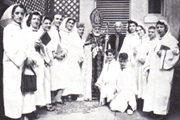
The cultural and social activities of the community were further enriched by the formation of the Ani chapter of the Knights of Vartan in 1942 and later the Daughters of Vartan Dikranouhi Otyag in 1953. The Armenian Students’ Association was also established in 1947 hosting national conventions in 1957 and in 1962. The group disbanded in the early 1970’s.
An Armenian Evangelical group was also established in Washington. In 1941 the Rev. Hovannes Krikorian organized the community as an Armenian Presbyterian Church. In the 1970’s, the church was reorganized into the Armenian Evangelical Fellowship. The fellowship still hosts periodic services with the support of visiting clergy. Since the 1950s, Soorp Khatch Armenian Apostolic Church located in Bethesda, Maryland under the jurisdiction of the Great House of Cilicia, has also helped nurture the spiritual need adding to the cultural life of Washington’s Armenian community.
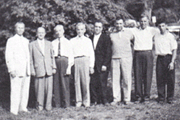
Post World War II to the Present
After World War II, the Armenian community in the Washington Metropolitan area grew to approximately 250 families. A new generation of professionals and students contributed to the changing character of the community and the growth of social activities. As the community grew, so did its need for spiritual nourishment. As a result, parish leaders and the Primate, Archbishop Tiran Nersoyan, worked tirelessly to acquire a church building. In 1954 their efforts culminated in the purchase of an unfinished structure for $32,000 that today is the lower level of the present church. The Very Reverend Torkom Manoogian, of blessed memory, who went on become the Primate of the Eastern Diocese and also Armenian Patriarch of Jerusalem, frequently made the trip from Philadelphia to serve as the visiting pastor. This was later followed by the appointment of Father Levon Arakelian as the Visiting Pastor in 1953.
Soon after the parish purchased its new site, Sunday services began on a regular basis led by visiting clergy as well as the Deacon-in-Charge Krikor Vosganian. By the end of the first full year, the church held weekly services, conducted sacraments regularly, commemorated the 40th Anniversary of the Armenian Genocide, and began the task of constructing a new sanctuary. The Architect Mihran Mesrobian volunteered to lead the design and work associated with the new sanctuary. The Armenian Church Youth Organization of America, established in Providence, RI in 1946 also opened a chapter in Washington D.C. In 1956, Washington was the site of the 10th Annual ACYOA General Assembly. The Assembly also returned to Washington in 1996, 2003 and 2008. In 1955 the first Sunday School classes were held at St. Mary and on April 28, 1958 the community gathered to burn the original mortgage document in a ceremonial gesture.
Parish Life Begins
Within a few years, the church began an effort to raise funds to construct a new church and to support the hiring of a resident pastor. On January 7, 1960, the Very Reverend Karekin Kazanjian was appointed to serve as the pastor. During Father Karekin’s tenure, a new era in church activity began. He worked tirelessly to reach out to community and generate interest in church affairs among many newly established families as well as the youth.
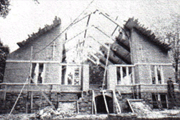
Through his efforts, the activities and organizations of the church generated more enthusiasm and the church gathered strength. He organized the “Shnorhali Club” to attract young couples and young adults to join the church. Soon after Father Karekin’s arrival, the community was honored by a visit from the Catholicos of all Armenians, His Holiness Vasken I. His Holiness celebrated the Divine Liturgy in the church and presided over a banquet attended by Armenians from the Washington community and other nearby cities.
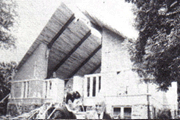
In early 1963, the construction of the new church began. The Primate, Archbishop Sion Manoogian assisted by Father Karekin and the Very Reverend Guregh Kapikian of the St. James Brotherhood of Jerusalem laid the cornerstone of the church on Sunday, March 10, 1963. The new sanctuary was completed on November 10, 1963. On that day, the church was filled to capacity before the Matins service. Neshan Hintlian, who had been asked to propose a name for the church, stood in front of the main Altar as the
Godfather. Mr. Hintlian asked that the church be named St. Mary in honor of the Holy Virgin Mary and in memory of his daughter, Mariam, who had passed away at an early age. The Godfathers of the side Altars were Dikran Koumjian, the Building Fund Chairman, and Vahan B. Kurkjian, the Parish Council Chairman.
Following the consecration service, the Divine Liturgy was celebrated by the Primate, Archbishop Sion Manoogian; assisted by the Vicar General, the Very Reverend Yeghishe Gizirian; the pastor, Father Karekin and Reverend Levon Arakelian.
Following the Divine Liturgy, a banquet was held in the church hall.
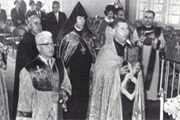
After leaving St. Mary, Father Karekin went on to serve the Armenian Church in different capacities around the world. He eventually became the Patriarch of Constantinople. In May 1967, the Primate, Bishop Torkom Manoogian assigned the Very Reverend Paren Avedikian to take over as the parish priest.
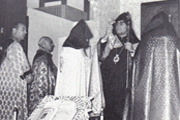
From 1969 to 1975 the Bishop Papken Varjabedian served as the pastor of St. Mary Church. He also served as the Diocesan Legate, representing the Armenian Church to the U.S. government as well as in ecumenical affairs. In 1972, the Armenian Assembly of America was established in Washington as an advocacy group working to support Armenian interests and to raise public awareness of critical issues.
In the 1960s and 1970s the steady influx of new Armenians to the Washington metropolitan area continued. This included professionals, job seekers and students from New England, the mid-Atlantic, and from other U.S. regions as well as new immigrants from Istanbul, Beirut, Damascus, Aleppo, Cairo, and various cities in Iran. With the collapse of the Soviet Union and the disastrous earthquake in Armenia, another wave of immigrants would arrive later, this time from the Motherland.
In April 1976, The Reverend Father Vertanes Kalayjian was assigned as the visiting pastor. He officially assumed the pastorate in January 1977 where he served with his wife the Yeretzgin Anahid Kalayjian for 31 years. In 1985, on the occasion of the 25th anniversary of Father Vertanes’ ordination, he was granted, by His Holiness the late Catholicos Vazken I, the title of Avak Kahana (Archpriest) and the privilege of wearing the Lanchakhatch (Pectoral Cross). While serving the D.C. community, Father Vertanes started an outreach effort to the Baltimore Armenian community. To this day, the spiritual needs of the Baltimore Community are administered by the pastor of St. Mary.
As the parish grew, so did its activities, and consequently, the need for additional space. An adjoining building to the church was constructed to include a new hall, additional classrooms and office space, and a library. Many parishioners and friends from around the country contributed their time and resources to raise nearly $350,000 and to design the plans and secure the permission needed to complete the first phase of the project. On September 1, 1981 the Primate Archbishop Torkom Manoogian dedicated the new building. In the mid-90’s the second phase was completed which included a new church entrance and an outdoor elevator for handicapped access.
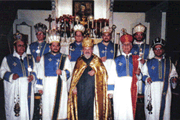
In the aftermath of the devastating earthquake that struck Armenia in December 1988, the community banded together to assist the Motherland with rescue relief and rebuilding efforts. The St. Mary Parish contributed an estimated $600,000 including $350,000 and additional in kind support by way of food, clothing, medication and medical supplies. In 1987 and again in 1989 the church was blessed by a pontifical visit by His Holiness the late Catholicos Vazken I. In 1988, His Holiness, Catholicos Vazken I honored Col. George Juskalian, a devoted St. Mary parishioner, member of numerous Armenian boards and decorated war hero, the St. Nersess Shnorhali Medal. The U.S. government also recognized his service when, in 2011, the Sully Station Post Office in Centreville, Virginia was named in his honor.
An independent Armenia also posed a formidable challenge to the Diaspora; particularly Armenia’s thirst for spiritual nourishment. In response, the parish generously supported Father Vertanes who was the Co-Founder and Vice-Chairman of HAVAD, the Diocesan Christian Missionary program in Armenia. Father Vertanes and Yeretzgin Anahid spearheaded the Diocesan project that today continues to provide assistance in caring for orphans and orphanages in Armenia. Other key moments include hosting the Diocesan Assembly in 1980, the movement of the Armenian school under the jurisdiction of St Mary in 1978 and the official chartering of a bookstore in 1982. In 1982 the Women’s Guild, which has been a steady and consistent source of support for the church celebrated its 50th anniversary. In 1984, the charter for the Balian Library was approved and the church received a generous donation, including books and records, from Rita and Vartkess Balian in memory of his parents – Dikranouhi and Mardiros Balian – who were Genocide survivors. In 2001, His Holiness, Catholicos Karekin II bestowed upon Mr. and Mrs. Balian, long-standing parishioners of St. Mary, the St. Nersess Shnorhali Medal for their service to the Armenian nation and church.
Other key milestones in the 1990’s included a pontifical visit by his Holiness the late Karekin I (1996), and the start of the Lenten Food Festival organized by the Women’s Guild. The church was also active in raising funds for Armenia and Artsakh. Father Vertanes also led the organization in a series of prayer vigils and demonstrations on the steps of the Capitol and the White House, in support of Artsakh. During this time, a group of parishioners and other concerned members of the community came together to form the Armenian-American Action Committee, a grassroots anti-defamation organization. It is now affiliated with the Armenian Assembly.

Following the creation of a newly independent Armenia in 1991, newly established diplomatic relations resulted in the opening of an embassy facility in 1993. A number of parishioners played critical roles in securing and renovating the building that today serves as the Embassy. Mr. Vartkess Balian chaired the committee that spearheaded the design and renovation efforts and, for 15 years, volunteered resources to maintain its up-keep. His Excellency, Ambassador Rouben Shugarian served as the first envoy of the Republic of Armenia. The current ambassador, His Excellency Tatul Markarian, was appointed on March 19, 2005.
Since 2000, the parish has also benefited from the leadership of the Archbishop Vicken Aykazian as the Ecumenical Legate for the Eastern Diocese of the Armenian Church of America based in the Nation’s Capital. Through his affiliations with and leadership within ecumenical and interfaith organizations, the Legate builds relationships with other Christian and non-Christian denominations, interacting and exchanging ideas with their respective leaders and communities. In 2009-2010, Archbishop Aykazian became the first ordained clergyman from an Oriental Orthodox Church to be elected to serve as President of the National Council of Churches of Christ, the oldest Christian ecumenical group in the United States. Archbishop Aykazian also serves on the board of the World Council of Churches that reaches out to churches in 110 countries and of Habitat for Humanity International, which is a non-profit that builds homes for the disadvantaged throughout the world.
In 2007, Father Hovsep and Yeretzgin Jennifer Karapetyan joined the community and began their ministry at St. Mary. Father Hovsep and Yeretzgin Jennifer have built upon the foundation of the many who have come before and continue the good work to carry forth the ministry and mission of the church.
In the Fall of 2007, the Washington community was honored by the visit of His Holiness Karekin II, Supreme Patriarch and Catholicos of All Armenians. During his Holiness’ visit on Oct. 9, a special Hrashapar service took place at St. Mary welcoming His Holiness with the participation of numerous ecumenical guests, dignitaries and parishioners. Between 2007 and 2008, the Parish started major construction during which the social halls were completely renovated. Renovation works continued with significant updates in the church kitchen and the building of a new baptismal font in the sanctuary. In 2010, the church adopted a new investment policy for managing the church’s financial assets more efficiently and the leadership of the Church continued to work hard to invest for the future of the community.
In 2010 the Washington community was blessed to witness the first ever ordination of a priest on the holy altar of St. Mary Church. The long-time parishioner and founder of the St. Narek Bell choir, Deacon Khoja-Einatyan was ordained into the Holy Priesthood, receiving the priestly name Father Hovhan. The Parish Council and the community served as Godfather of his ordination. In 2011, the parish laid to rest one of its longest serving members Ms. Anne Kavookian. She was a devoted Sunday School teacher, longstanding member of the Women’s Guild, and quiet pillar of strength and service to the St. Mary church community.
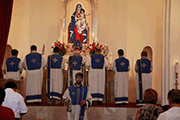

In May 2012 a beautiful Khachkar carved in Armenia was erected at the Church entrance courtyard. It is a steadfast symbol of Christian hope for members of the community. The Primate, Archbishop Khajag Barsamian blessed the new Khachkar and also ordained a sub-deacon and several acolytes. Several young altar servers also received a blessing on the day and parishioner Arsen Sayan, founder and conductor of the church's Ani Armenian Choral Group, received the St. Sahag and St. Mesrob medal and a pontifical encyclical.
This honor was in recognition of his devotion and dedication to the church and contribution to Armenian music. The choral group participated in the celebration of the Divine Liturgy. The Khatchkar was erected in memory of all who served St. Mary Armenian Apostolic Church and was made possible by donations given in memory of Mr. Vartkess Balian.
In June 2012, major construction efforts began to update and renovate the church sanctuary. The work, which was supported through generous donations from parishioners, included a complete enhancement of the main altar and side altars as well as the candle boxes reflecting Armenian architectural elements. A new choir loft was also constructed in the back of the church. This renovation work culminated in a special dedication service and banquet on September 2 2012, led by the Primate, Archbishop Khajag Barsamian. The entrance of the church was enhanced with the addition of an Armenian Church bell-tower, magnificent hard-carved door with angels and Armenian ornaments. A breathtaking tufa stone carving of St. Mary ornate with grapes, vine leaves, branches and pomegranates was placed at the main entrance to the church above the door.
Members of the St. Mary Armenian community, together with Father Hovsep, also traveled on a pilgrimage to Armenia where they visited Holy Etchmiadzin and many other historic sites. In 2012, Father Hovsep also led a group of parishioners on a trip to the Holy Land. The group was able to visit many of the historic Christian sites and witness the treasures of the Armenian religious heritage. Under Father Hovsep’s leadership, St. Mary continues with its ministry and outreach through religious, cultural and educational programs
Today, the Church continues to be blessed to have hard working community leaders and volunteers who keep the Armenian spirit in Washington alive. St. Mary Armenian Church continues to flourish and serve its community through sacramental life, such as the celebration of the Holy Badarak, weddings, and baptisms and through additional community activities and outreach, utilizing its various parish organizations.
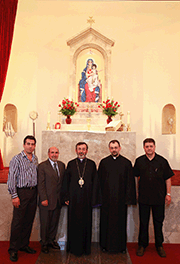
The Parish Council, Diocesan Delegates, Women’s Guild, the Ararat Avak Society, the ACYOA & the ACYOA Jrs., the Choir, the Couples Ministry, the Shnorhali and Sunday Schools, the Board of Stewards, and the St. Mary Bookstore have combined their efforts to create a rich atmosphere of service to God and fellowship among Armenian Christians. These individuals and organizations throughout the years have organized a wide range of cultural, spiritual and social activities. They have also helped to support numerous fundraising activities.
With many talented individuals contributing to the life of the church and the Armenian community, it was inevitable that St. Mary’s would proudly boast countless cultural and educational activities including: art exhibitions; cultural education symposiums and lectures; Christian education seminars, retreats, and bible studies; musical, theatrical, and folk dance programs; the choral group; concerts; and book signings.
The Washington Armenian community is diverse. There are Armenians from nearly every continent among us, with a variety of backgrounds and life experiences, each adding a unique element to our community. Our strength lies in our ability to rally around our Armenian heritage and Christian faith. The future holds vast opportunities and requires each member of our community to contribute something special to ensure the success of future Armenian generations in our Nation’s Capital.



